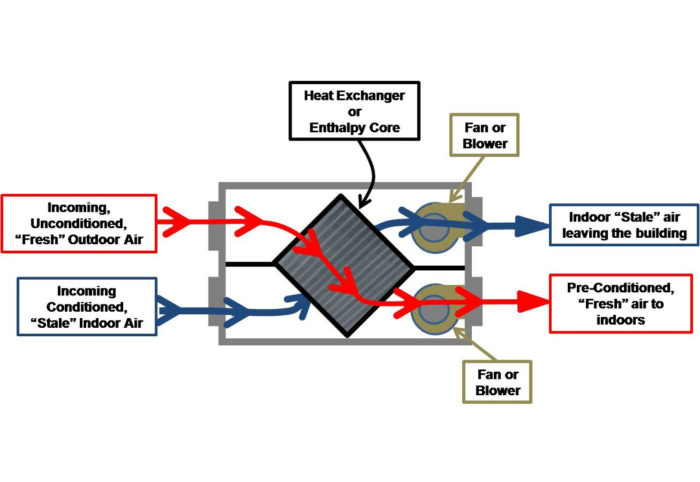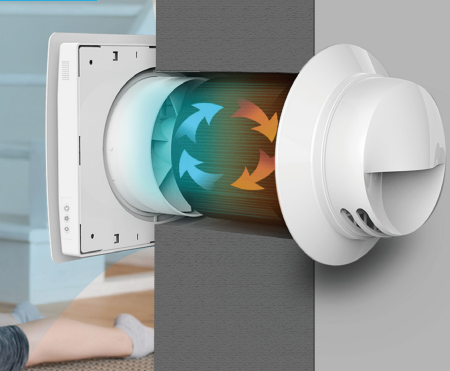Discovering the Benefits of Heat Recovery Ventilation for Energy Performance in Houses
Heat Recovery Ventilation (HRV) systems use home owners a practical approach to boosting energy efficiency. By recovering warmth from outbound air, these systems can significantly lower heating & cooling prices. Additionally, they provide a stable supply of fresh air, enhancing indoor air quality and convenience degrees. As homeowners consider lasting alternatives, comprehending the subtleties of HRV systems ends up being significantly important. What factors should one examine before making such an investment?
Understanding Heat Recovery Ventilation Systems

Just How HRV Improves Indoor Air Quality

Energy Savings: The Financial Advantages of HRV
Making best use of energy performance, heat recovery ventilation (HRV) systems offer significant monetary advantages for home owners. By recouping and reusing warmth from exhaust air, HRVs substantially reduce heating and air conditioning prices. This modern technology can result in power savings of up to 30%, relying on environment and use patterns. Homeowners frequently discover minimized energy bills quickly after installation, making HRVs a monetarily smart financial investment over time. Furthermore, lots of areas provide motivations or refunds for energy-efficient upgrades, additionally boosting the economic appeal. As energy costs remain to rise, the cost-effectiveness of HRVs comes to be progressively clear. On the whole, the consolidation of HRV systems not only promotes power performance but likewise adds to long-term economic savings for families.
The Ecological Influence of Heat Recovery Ventilation
A significant environmental advantage of heat recovery view ventilation (HRV) systems exists in their ability to decrease total power consumption. By redeeming warm from exhaust air and transferring it to incoming fresh air, HRV systems minimize the need for energy-intensive home heating and cooling approaches. This reduction in energy need contributes to decrease greenhouse gas emissions, as less nonrenewable fuel source is called for to preserve comfy indoor temperatures. Furthermore, HRV systems enhance interior air quality by efficiently trading stale air with fresh outdoor air, minimizing reliance on mechanical cooling systems that can advice hurt the setting. Overall, the application of HRV systems sustains sustainable living techniques and lines up with international efforts to deal with climate change by advertising energy efficiency in property setups.
Selecting the Right HRV System for Your Home
How can home owners guarantee they select the best heat recovery ventilation (HRV) system for their needs? They must analyze their home's dimension and format, as these variables influence air movement demands. Next off, assessing the system's performance scores is vital, as greater scores suggest much better efficiency and power savings. Home owners must also think about installment and upkeep costs, contrasting various brand names and designs for value. Additionally, it's crucial to examine sound levels, as some systems run more quietly than others. Consulting with heating and cooling specialists can supply customized referrals based on details home conditions. Ultimately, taking a look at individual evaluations and service warranties can help in making a notified decision, making certain that the chosen HRV system successfully boosts interior air top quality and power efficiency.
Regularly Asked Questions

Exactly how Commonly Should I Tidy or Maintain My HRV System?
The regularity of cleansing or maintaining a warm healing air flow (HRV) system normally depends on usage and environmental elements. Typically, it is advisable to do upkeep every 6 months to assure peak efficiency and air high quality.

Can HRV Solutions Help Lower Humidity Levels Inside Your Home?
HRV systems can effectively decrease interior moisture degrees by trading stale, humid air with fresh, drier air from outdoors. HRV Heat Recovery Ventilation. This procedure helps keep a balanced indoor environment, enhancing comfort and preventing moisture-related problems
What Is the Life expectancy of a Regular HRV System?
The life expectancy of a regular heat recovery ventilation (HRV) system varies, generally lasting in Go Here between 10 to 15 years. Regular maintenance can expand its effectiveness and operational life, making sure peak performance throughout its usage period.
Exist Any Type Of Sound Interest In HRV Systems?
Sound interest in HRV systems can arise, especially from follower procedure. Nevertheless, lots of contemporary systems are designed to reduce audio levels, ensuring they run silently while preserving performance, which resolves possible disturbances in living settings.
Can I Install an HRV System Myself, or Do I Need an Expert?
The individual contemplated whether to set up the heat recovery ventilation (HRV) system personally or employ a professional. Generally, while do it yourself installment is possible, expertise warranties proper performance and compliance with regional building ordinance, boosting system efficiency.